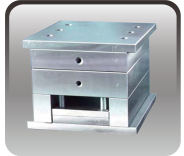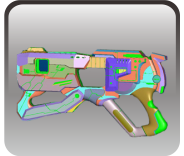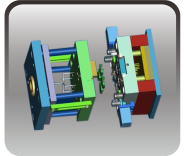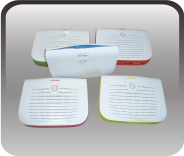Prototyping Molding(10-10000pcs)
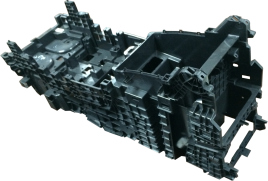
Low Volume Production 10pcs to 10,000pcs from Prototype Injection Molding
Rapid Tooling / Prototyping :( Low Volume Production : Number of application:100 to 10 000 parts )
Vowin offers a wide variety of rapid tooling technologies, including Prototype / Bridge tooling and Short Run / Production tooling. We offer in-house services along with use of our database of reliable rapid tooling providers. Vowin produces injection mold rapid tooling to generate: Your requirements and your tooling expectations determine the method that we use to create your rapid tooling. Vowin will select the fastest and most cost effective method that meets your requirements. Our rapid tooling and prototyping engineering team stays up-to-date on the latest technologies and advancements in the industry. We will stay on top of the rapid tooling technology, allowing you to do your job and use our expert services as needed. Technical Overview of
Top 3 Ways why You Can Use Prototyping Molding to save Your time and cost :
1: Aluminum tooling --- Save the mould material cost,
2: old mould base tooling ---Save our make time.
3: same new mould base different core Tooling.----we can repeat use the mould base . so You can be better than ordinary mould province 60%.
for our Rapid Tooling. Aluminum tooling is versatile approach to Rapid Tooling, it can be CNC machined, EDMed, textured and can create undercuts. also old mould base tooling meaning use no need mould change to your project new core . and same mould base but different project core tooling meaning many project's new core use the same new mould base We can mold most all thermoplastic materials. Engineering grade resins can also be molded. Rapid Tooling FAQs Q: What lead times are available? A: Tooling lead times range from 2-6wks Q: Can part have undercuts? A: Parts can be molded with undercuts. Cams, slides, and lifters can be incorporated into the tooling. For low part volumes, hand loaded inserts can be used to help keep costs down.
How to make a Prototyping mold -4 Steps of Prototype Injection Molding:
At Creative Mechanisms we have solidified a four step process for Prototype Injection Molding. Find them below.
1. Product Design
During the initial design phase, we have to be careful not to get too hung up on the details. The goal here is to quickly establish design feasibility and get to a “proof of function” model. We don’t want to spend too much time designing a product whose parts are logistically un-producible because then the entire essence of the design will have to be changed later. This is a waste of time, and so we work hard to strike a balance between speed and production feasibility.
The ability to strike this balances comes with experience. Knowing if the part, as designed, will be able to be engineered for production has become a sixth sense – an art form, even – for the seasoned engineers here at Creative Mechanisms.
We also have design experts and tool builders that will be collaborating with our engineers throughout this stage. No project moves forward without a unanimous agreement that the design is the best it can be for production.
2. Engineering for Production
When we move on to this step, it means that we have completed our design and proven its functionality. Now is the time to engineer the parts that are necessary for production. This must be done because the parts are going to be produced in a steel tool; they must be tapered so that they can be easily ejected from the tool. The parts must also have walls that are evenly thick and must have no undercuts to prevent the steel halves from opening or cause the part to be trapped in one half of the tool. We then need to determine where the plastic will be injected – also known as the gate – and then analyze how the material will flow into the part from the gate.
Our experienced engineers know that the wall thickness must be adjusted to allow the material to flow evenly throughout the part from the gate location. Trapped air causes problems, and our seasoned engineers call on their experience to look at the part, visualize the material flowing through it, and then to make adjustments to improve what they see.
3. Mold Design and Construction
The part has been designed and engineered; now we have to design and engineer the mold that will create the part. There are plates that need to be created with pins that will push the part out of one half of the mold and water lines need to be run in order to cool the part quickly once the cavities have been filled with the plastic. The tool will require additional pieces – more than just the two halves – if the part has a complicated geometric pattern of some sort.
Creative Mechanisms uses Mold Flow Analysis software that simulates the flow of specific materials through the mold, helping us determine gate locations and showing possible gas traps or areas that won't fill properly.
Here is a sample of a Mold Flow Analysis of a part:
4. Using the Injection Mold Machine
The mold is then put into our injection molding machine and “shot” for the first time. This means that molten plastic is injected – shot – into the mold. The mold’s halves are held together with extremely high pressure – usually hydraulic – while the molten plastic is forced inside. After the plastic is forced into the mold, it's cooled with water. The pressure is then released, the mold opens up, and the part drops out.
And an injection molded prototype has been made.
What Is Our Injection Molding Process?
Our prototype injection molding begins with a manufacturing process in which plastic material is forced into a mold cavity under pressure. Pelletized resins are fed into the injection molding machine, as well as any colorants required. The resins and colorants are introduced into an injection barrel where they are heated and melted. The material is then forced into the mold cavity where it cools. Once cooled, the part can be removed from the mold cavity.
Our Injection Molding Machines
With injection molding machines ranging from 7-500 tons we can provide engineering-grade injection molded parts fast and affordable, reducing your time to market. Our variety of press sizes allow us to meet your plastic injection molding needs from 10 to 100,000+ parts.
Prototype Tooling & Injection Molding
Many rapid prototyping processes are great for testing form and fit, but often times there is simply no substitute for testing with the real injection molded parts and material. When your production tooling won’t be ready for months, prototype injection molding is a great way to receive parts quickly and inexpensively. We can use various materials and techniques to create bridge tooling for prototype testing and evaluation.
Q: Do I need draft?
A: As with any plastic part that is to be injection molded, draft is needed. The degree of draft is dependent on several factors, depth of draw, surface finish, textures. 1 degree draft is typically adequate.
Q: Can I have a texture applied?
A: can have textures applied. They can be bead blasted or sent out for specific textures.
Q: What type of CAD file will you need to quote tooling?
A: The file format needed for tooling quotes is STEP, IGES, Pro/Engineer, or SolidWorks
Q: How about the cost if use vowin's rapid tooling method
A: it's will save your many cost, if use our 1: Aluminum tooling . 2: old mould base tooling . 3: same new mould base different core Tooling

